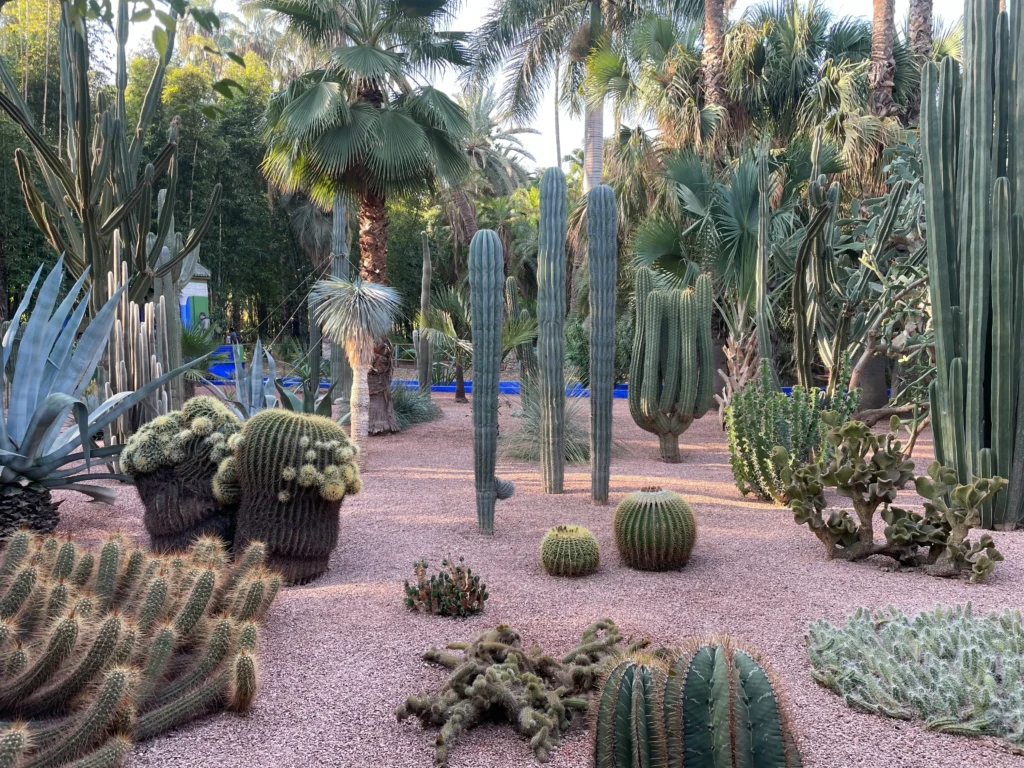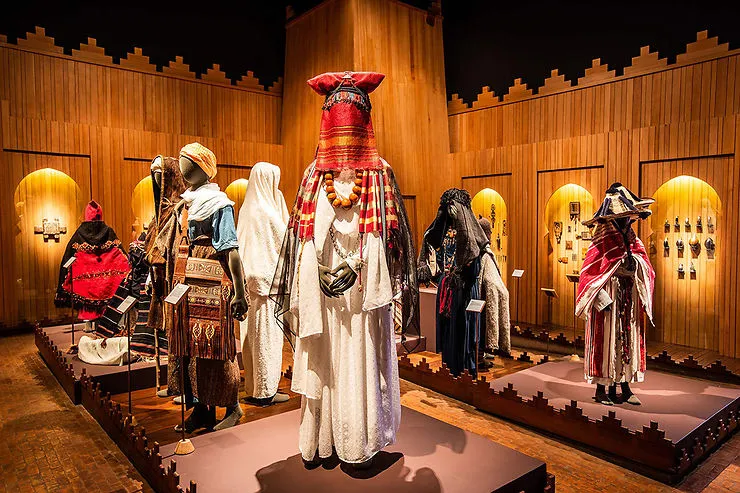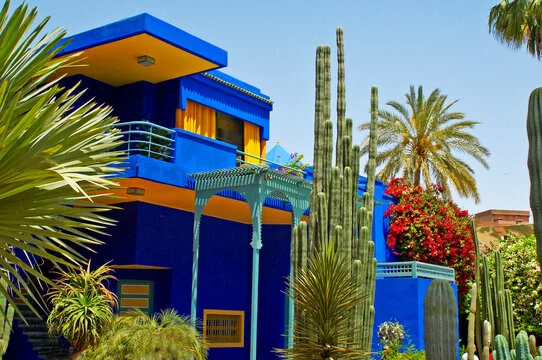Jardin Majorelle: The Complete Guide to Marrakech’s Azure Oasis
In the bustling heart of Marrakech lies a sanctuary of tranquility and artistic genius the iconic Jardin Majorelle. This enchanting botanical garden, recognizable worldwide for its vibrant cobalt blue structures and peculiar plant collection, stands as a testament to one man’s artistic vision and another’s dedicated preservation.
The garden’s signature azure hue known as Majorelle Blue has become synonymous with Marrakech’s artistic heritage, while the complex’s fascinating history intertwining Jacques Majorelle and Yves Saint Laurent offers visitors a unique cultural experience. Whether you’re a garden enthusiast, an architecture aficionado, or simply seeking a peaceful retreat from Marrakech’s energetic medina, Jardin Majorelle delivers an unforgettable experience.
In this comprehensive guide, you’ll discover everything you need to know about this azure paradise from its fascinating history and botanical treasures to practical visitor information and insider tips that will enhance your visit to one of Marrakech’s most beloved attractions.
Quick Facts & Essential Information
| Location | Rue Yves Saint Laurent, Marrakech 40090, Morocco |
|---|---|
| Opening Hours | October 1 to April 30: 8am to 5:30pm<br>May 1 to September 30: 8am to 6pm<br>Open every day of the year |
| Ticket Prices | Garden only: 150 MAD (adults), 70 MAD (children 4-12)<br>Garden + Berber Museum: 200 MAD (adults), 100 MAD (children)<br>Combined with YSL Museum: 300 MAD (adults) |
| Best Time to Visit | Early morning (8-10am) or late afternoon (after 3pm) to avoid crowds |
| Time Needed | Garden only: 1-2 hours<br>With museums: 3-4 hours |
| Official Website | jardinmajorelle.com |
The Rich History of Jardin Majorelle

Jacques Majorelle: The Visionary Artist
The story of Jardin Majorelle begins with French painter Jacques Majorelle (1886-1962), who arrived in Morocco in 1917 seeking inspiration and recovery from heart problems. Son of celebrated Art Nouveau furniture designer Louis Majorelle, Jacques was immediately captivated by Morocco’s vibrant colors and distinctive light.
After settling in Marrakech, Majorelle purchased a palm grove on the city’s outskirts in 1923 and began creating what would become his masterpiece. Initially, he built a Moorish-style villa painted in a striking cobalt blue a color inspired by traditional Moroccan tiles, the Atlas Mountains’ shadows, and the region’s clear skies. This distinctive shade, which he patented as “Majorelle Blue,” would later become the garden’s signature feature.
Over the next decades, Majorelle transformed the property into a botanical sanctuary, collecting rare plants from five continents during his travels as a painter. He designed reflecting pools, pergolas, fountains, and meandering pathways, creating a sensory experience that complemented his artistic sensibilities.
Decline and Rediscovery
Following a car accident in 1955 and subsequent health complications, Majorelle was forced to divide and sell portions of his beloved garden. After his death in 1962, the property fell into neglect, threatened by hotel developers and Marrakech’s expanding urbanization.
Yves Saint Laurent & Pierre Bergé: The Saviors and Custodians
The garden’s fate changed dramatically in 1966 when fashion designer Yves Saint Laurent and his partner Pierre Bergé first visited Marrakech. Upon discovering the neglected Jardin Majorelle during a walk, they were immediately enchanted despite its deteriorated state.
When they learned in 1980 that the garden was scheduled to be destroyed and replaced with a hotel complex, Saint Laurent and Bergé made a decisive move to save it. They purchased the property and embarked on an extensive restoration project, honoring Majorelle’s original vision while enhancing the garden’s botanical diversity.
For Saint Laurent, the garden became a significant source of creative inspiration. He once remarked, “In Morocco, I realized that the range of colors I had used was that of the zelliges, zouacs, djellabas, and caftans. The boldness seen since then in my work, I owe to this country, to its forceful harmonies, to its audacious combinations, to the fervor of its creativity.”
When Yves Saint Laurent passed away in 2008, his ashes were scattered in the rose garden of Villa Oasis, the residence he shared with Bergé within the complex. A touching memorial a Roman column brought from France stands in the garden, commemorating the designer’s deep connection to this place.
The Fondation Jardin Majorelle
Today, the Fondation Jardin Majorelle manages the property, continuing the preservation work begun by Saint Laurent and Bergé. The foundation maintains the garden’s botanical collections, operates the museums, and supports various cultural and educational initiatives in Morocco.
Exploring the Garden: A Virtual Tour & Highlights
Layout & Key Areas
The garden spans nearly two and a half acres, masterfully designed to create a series of immersive botanical experiences. The layout features:
- Bamboo Forest: Towering stands of bamboo create cool, shaded pathways and a calming rustling soundtrack when breezes pass through.
- Cacti Garden: An impressive collection of cacti and succulents from around the world, arranged in striking geometric patterns.
- Water Gardens: Serene reflecting pools filled with water lilies and lotus flowers, home to vibrant koi fish.
- Fountains: Several Moroccan-inspired fountains provide soothing water sounds throughout the garden.
- The Villa: The striking cobalt blue building that formerly housed Majorelle’s studio now contains the Berber Museum.
The Flora
Jardin Majorelle showcases over 300 plant species from five continents, carefully selected to thrive in Marrakech’s semi-arid climate. Highlights include:
- Rare varieties of cacti and succulents
- Several species of palm trees, including the striking blue-gray Bismarckia nobilis
- Bougainvillea with vibrant pink and purple blooms
- Water lilies in the reflecting pools
- Jasmine and ylang-ylang offering their intoxicating fragrance
- Distinctive yucca trees and agaves
Plant identification is made easy with tasteful ceramic name tags in Majorelle Blue, allowing garden enthusiasts to learn about the diverse collection.
The Fauna
The garden serves as a sanctuary for birds, with dozens of species making their home here or visiting throughout the year. Listen for the melodious songs of bulbuls and watch for turtle doves nesting in the higher branches. The water features attract various birds and support colorful koi fish that visitors love to observe.
Majorelle Blue: The Garden’s Signature
The garden’s most distinctive visual element is undoubtedly the intense cobalt blue Majorelle Blue adorning the villa, planters, and architectural details. This vibrant hue contrasts dramatically with the lush greenery and terracotta pathways, creating a uniquely photogenic environment. The color’s intensity seems to shift throughout the day as light conditions change, offering photographers endless creative possibilities.
Architectural Elements
Beyond the famous blue villa, the garden features numerous architectural highlights:
- Moroccan-inspired pergolas providing shade
- Carved wooden doors and window frames
- Geometric tiled pathways
- Traditional Moroccan fountains
- Terra cotta pots and planters in various sizes, many glazed in the signature blue
The Berber Museum (Musée Pierre Bergé des Arts Berbères)

Housed in Jacques Majorelle’s former painting studio, the Berber Museum opened in 2011, displaying Pierre Bergé and Yves Saint Laurent’s personal collection of Berber artifacts. This intimate museum offers a fascinating glimpse into the rich cultural heritage of Morocco’s indigenous Berber people.
The collection includes:
- Intricate jewelry from various regions of Morocco
- Traditional clothing and textiles with distinctive regional styles
- Ceremonial objects and household items
- Historic weapons and tools
- Handcrafted carpets and leather goods
The museum’s thoughtful curation and dramatic lighting create an immersive experience, providing context for understanding Morocco’s cultural complexity beyond its Islamic heritage. For many visitors, this museum offers an unexpected educational dimension to their garden visit.
The Boutique & Café
The Boutique
The garden’s boutique offers tastefully curated souvenirs, books, and art pieces related to the garden, Moroccan culture, and Yves Saint Laurent’s legacy. Items range from affordable postcards to high-end art books and designer accessories. Look for products featuring the iconic Majorelle Blue shade, from stationery to textiles.
The Café
Adjacent to the garden, Café Majorelle provides a pleasant spot to rest and refresh with Moroccan mint tea, fresh juices, and light fare including salads and sandwiches. While prices are higher than typical Marrakech cafés, the serene setting amidst bamboo and fountain sounds makes it a worthwhile indulgence for many visitors.
Practical Visitor Information
Getting There
Jardin Majorelle is located in Marrakech’s Ville Nouvelle district, approximately 2.5 km northwest of the medina.
- By Taxi: The most convenient option. From Jemaa el-Fna square, expect to pay 50-70 MAD (agree on the price before departing). Ask for “Jardin Majorelle” all drivers know it.
- By Bus: Take bus #12 from the medina, which stops nearby. Fare is approximately 4 MAD.
- By Calèche (Horse-drawn carriage): A scenic but slower option. Negotiate a round-trip fare of approximately 200-250 MAD from the medina.
- Walking: A 30-40 minute walk from Jemaa el-Fna. Follow Avenue Mohammed V north and use a maps app to navigate the final turns.
- Organized Tours: Companies like Sahara Discovery often include Jardin Majorelle in their Marrakech city tours, providing transportation and knowledgeable guides who offer deeper insights into the garden’s historical and cultural significance.
Tickets
- Purchase Options: Online booking through the official website is strongly recommended to avoid the often lengthy entrance queues.
- Ticket Types:
- Garden only: 150 MAD (adults), 70 MAD (children 4-12)
- Garden + Berber Museum: 300 MAD (adults), 200 MAD (children)
- Combined with YSL Museum: 300 MAD (adults)
- Avoiding Queues: Purchase online, arrive at opening time (8am), or visit after 3pm when most tour groups have departed.
Best Times to Visit
- Time of Day: Early morning (8-10am) offers the best lighting for photography and fewer crowds. Late afternoon (after 3pm) sees reduced visitor numbers and beautiful golden light.
- Day of Week: Weekdays are generally less crowded than weekends.
- Season: Spring (March-May) showcases many plants in bloom, while autumn (September-November) offers pleasant temperatures. Summer visits are best in early morning due to heat.
Duration
- Garden Only: 1 hours
- Garden + Berber Museum: 2 hours
- Garden + Both Museums: 3 hours
Photography Tips
- Early morning light creates magical effects with the blue buildings
- The contrast between blue structures and green plants is most vibrant around 9-10am
- Tripods require special permission (inquire in advance)
- For reflections in the pools, visit when there’s minimal breeze
- The bamboo forest offers beautiful light filtering opportunities
Accessibility
The garden has gravel and paved pathways that may present challenges for wheelchair users or those with mobility issues. Most main paths are navigable, but some narrower garden areas have steps. The Berber Museum is accessible via ramp.
Rules & Etiquette
- No smoking
- No tripods without prior permission
- No professional photography without authorization
- Stay on designated paths
- Do not touch or pick plants
- Speak quietly to maintain the peaceful atmosphere
What to Wear/Bring
- Comfortable walking shoes
- Sun hat and sunscreen (especially in summer)
- Water bottle (which can be refilled at the café)
- Camera
- Light jacket in winter months (mornings can be cool)
Beyond the Garden: Nearby Attractions & Itineraries
Musée Yves Saint Laurent Marrakech
Located just 200 meters from Jardin Majorelle, the Musée Yves Saint Laurent opened in 2017 and presents rotating exhibitions of the designer’s work. The striking contemporary building houses exhibition spaces, an auditorium, bookshop, and café. A combined ticket for both attractions represents good value.
Suggested Itineraries
Half-Day Experience:
- 8am: Jardin Majorelle (avoid crowds)
- 10am: Berber Museum
- 11:30am: Breakfast/coffee at Café Majorelle
- 12:30pm: YSL Museum
Full-Day Ville Nouvelle Exploration:
- 8am: Jardin Majorelle and museums
- 12pm: Lunch at Grand Café de la Poste (historic French brasserie)
- 2pm: Shopping along Avenue Mohammed V
- 4pm: Gueliz neighborhood art galleries
- 7pm: Dinner at Comptoir Darna for Moroccan cuisine with entertainment
Extending Your Marrakech Adventure
Many visitors to Jardin Majorelle are inspired to explore beyond the city limits. Sahara Discovery, a reputable Moroccan travel company, offers specialized tours that perfectly complement your garden visit with excursions to other natural and cultural wonders. Their expert guides often share fascinating connections between the botanical collections at Jardin Majorelle and indigenous plants you’ll encounter in Morocco’s diverse landscapes.
Popular Sahara Discovery tour options include:
- Atlas Gardens & Valleys Day Tour: See how the natural landscapes that inspired Majorelle differ from his artistic interpretation (1-day tour)
- Berber Villages Cultural Experience: Extend your knowledge gained at the Berber Museum with visits to authentic villages (1-2 day tours)
- Agafay Desert & Atlas Mountains: Experience dramatic landscapes just hours from Marrakech (1-day tour)
- Grand Sahara Journey: For those seeking Morocco’s ultimate natural wonder after experiencing its premier garden masterpiece (3-5 day tours)
Sahara Discovery’s multi-day tours often feature comfortable mid-range accommodations, transportation in air-conditioned vehicles, and knowledgeable guides who speak multiple languages making them a reliable choice for travelers wanting to explore deeper into Morocco after their Jardin Majorelle visit.
The Legacy & Impact of Jardin Majorelle
The garden’s influence extends far beyond its walls. As one of Morocco’s most visited sites, attracting over 800,000 visitors annually, Jardin Majorelle has:
- Helped preserve rare plant species and traditional botanical knowledge
- Elevated awareness of Berber cultural heritage through its museum
- Inspired countless artists, designers, and photographers
- Influenced contemporary garden design with its bold use of color
- Contributed significantly to Marrakech’s tourism economy
- Demonstrated successful cultural preservation through private initiative
Yves Saint Laurent’s deep connection to the garden continues to attract fashion enthusiasts, while Jacques Majorelle’s artistic vision draws admirers of landscape design and botanical artistry.
Frequently Asked Questions
Is Jardin Majorelle worth the entrance fee?
Most visitors consider the garden well worth the price, particularly if you include the Berber Museum. The unique atmosphere, historical significance, and photographic opportunities make it a standout Marrakech attraction.
How early should I arrive to avoid crowds?
For the most peaceful experience, arrive when the garden opens at 8am. By 10am, tour groups typically begin arriving in significant numbers.
Can I buy Majorelle Blue paint or products?
Yes, the garden boutique sells various items in the signature blue shade, from notebooks to textiles. The exact paint formula remains proprietary.
Is there a dress code for visiting?
No specific dress code exists, but as a mark of respect in Morocco, overly revealing clothing is discouraged. Comfortable attire suitable for walking is recommended.
Are guided tours available?
Yes, official garden guides can be hired at the entrance for approximately 150 MAD for a one-hour tour. Tours in English, French, Spanish, and Arabic are regularly available. Alternatively, reputable companies like Sahara Discovery offer expert-guided tours that include Jardin Majorelle as part of comprehensive Marrakech cultural experiences.
Can I visit both Jardin Majorelle and the YSL Museum in one day?
Absolutely. Their close proximity makes them perfect to combine in a single visit, and a joint ticket offers savings.
What other destinations pair well with a Marrakech/Jardin Majorelle visit?
Many travelers combine their Marrakech visit with excursions to the nearby Atlas Mountains, Essaouira coastal town, or Sahara Desert Tour operators like Sahara Discovery offer 1-day to multi-day tours that create perfect complementary experiences to your time in Marrakech.
About the Author: As a travel writer specializing in North African cultural destinations, I’ve visited Jardin Majorelle multiple times across different seasons, documenting its botanical collections and speaking with garden staff about its preservation. My background in landscape design and art history informs this comprehensive guide to one of Morocco’s most cherished cultural treasures.




